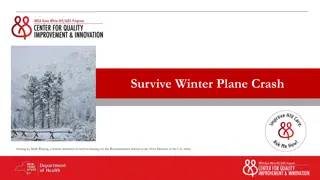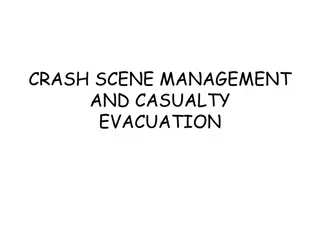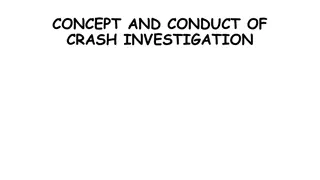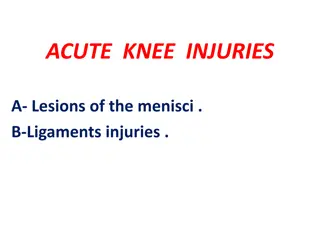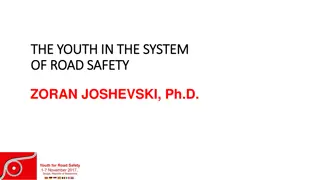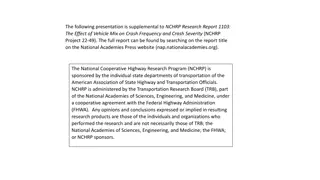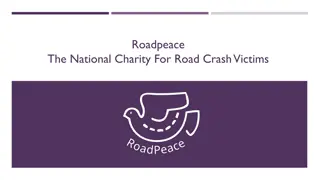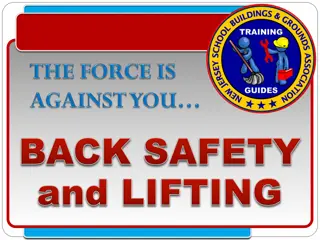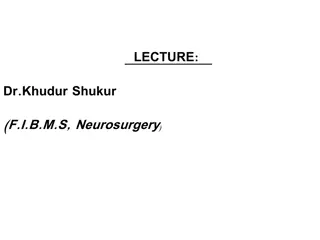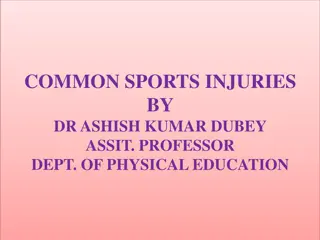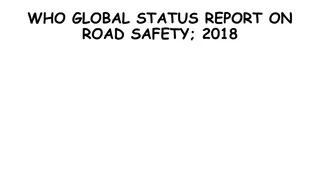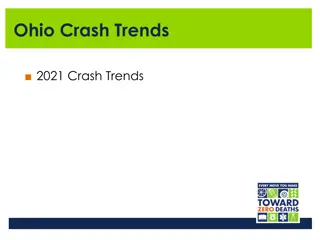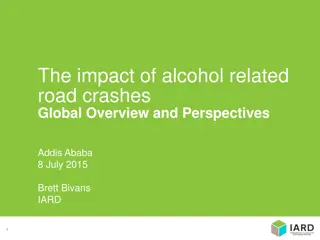Understanding the Road Crash Problem: Data, Injuries, and Trends
The road crash problem encompasses not only fatalities but also numerous injuries and collisions. Data sources include police records, hospital data, and injury board statistics. Trends show that while fatalities have declined faster than injuries in many countries, appropriate policies are crucial for addressing traffic risks effectively.
Download Presentation

Please find below an Image/Link to download the presentation.
The content on the website is provided AS IS for your information and personal use only. It may not be sold, licensed, or shared on other websites without obtaining consent from the author. Download presentation by click this link. If you encounter any issues during the download, it is possible that the publisher has removed the file from their server.
E N D
Presentation Transcript
How big is the Road Crash Problem ? Dr. Jack Short Trinity College Dublin 15 May 2018
The measurement issue Main measure is number of fatalities But there are also many injuries ( officially, 40 for each fatality) And many collisions not involving injuries ( officially,5 for each injury collision) Data on fatalities is pretty reliable but not on injuries or collisions
Injuries Matter They are numerous They are costly for society ( social costs are higher than for fatalities ) Trends are different (fatalities have declined faster than injuries in many Countries) Essential to understanding traffic risks (fatal collisions few and increasingly random) Appropriate policies may not be the same
Injuries : Data Sources Police (official data) Hospitals Injuries Board Accident and Emergency units General Practitioners Insurance Ambulance data
Data Obtained 73,000 Police records from 2005-2013 50,000 Hospital records from 2005-2013 70,000 Injury Board records from 2010-2013 2014 police data available only in June 2017 Anonymised datasets but with common variables age, gender, date, county, mode
Total injuries: injuries board, police, hospitals 20000 18000 16000 14000 12000 Injuries Board 10000 Police Hospitals 8000 6000 4000 2000 0 2005 2006 2007 2008 2009 2010 2011 2012 2013 2014
Age and Gender Structure Hospitals Police Injuries Board
Serious injuries: police and hospitals 1,600 Police-reported Hospitals 1,400 1,200 1,000 800 600 400 200 0 2005 2006 2007 2008 2009 2010 2011 2012 2013
Serious by Mode; Police and Hospitals Serious Injuries Ratio (H/P) Mode Hospital (MAIS3+) Police-reported Pedestrian 1.5 1,252 857 Cyclist 8.6 1,152 133 MotorCyclist 2.3 949 415 Vehicle Occupant 1.1 4,314 3,890 Total 1.4 7,667 5,295
How many Injuries annually? Police 8,000, Hospitals 5,000 and IB 18,000 Therefore between 18,000 and 31,000
Record linkage Police, Hospital, Injuries Board data linked Police-Hospitals 2005-2013 Police-Hospital-Injuries Board 2010-2013 5 Variables; age, sex, county, date of incident, mode
Police and Hospital data 2005-2013 Total 109,000
Police Hospital Matching 20% of police-reported are matched with a hospital entry. 28% of hospital patients are matched with a police reported injury. Only 9% for cyclists Over the 9 years about 36,000 hospitalised not recorded by police including over 6,000 with clinically serious injuries (MAIS3+) not recorded by police.
Matching: Severity summary A police-reported serious injury is as likely to be clinically serious as not A clinically serious injury is more likely to have been reported by the police as a minor rather than a serious injury These have changed over time So Police severity assessment is neither accurate nor consistent
How many injuries in all ? Police ? Insurance Total: 25 000 ? GPs ? A&E Hospitals Injuries Board 20 000 ?
Costs for Society Social Costs of Injuries underestimated by more than Euros 500 million annually Injuries cost significantly more for society than fatalities Costs of Material Damage collisions underestimated maybe by several hundred million This means that problem is much greater than shown in official figures Implies that more measures are cost effective than previously thought Especially measures for vulnerable users
AGS /RSA;2014 and 2013 compared 2013 2014 % Change Fatalities 188 193 3 All Injuries 6,880 8,079 17 Material Damage 22,000 35,000 54 Serious Injuries 508 755 48 Pedestrian 97 180 86 Cyclist 50 106 112 Motorcyclist 47 87 85 Car occupant 270 344 27 Other 44 38 -13.6
Conclusions: Data Issues Crash Data needs review - Definitions, processes, delays, availability - New series needed in addition to police data (using other sources and linkage) Serious injuries should not be assessed by police; -alternatives for police need to be examined (like UK check lists) Targets for serious injuries meaningless at present
Conclusions; economics/policy Social Costs estimates need to adjust for underreporting CBA needs to take specific account of injury impacts Injury undercount figures in appraisal need to be corrected (to 3 for serious injuries) Injury undercount should be mode specific Injuries need to be given more attention
Thank you for your attention Full paper on Statistical Society website http://www.ssisi.ie/JackShort_Oct12th.pdf shortj @tcd.ie




